The different types of project management office (PMO) is one of the new topics introduced as part of the 7th Edition of the APM Body of Knowledge. These different types of PMO can cause confusion for many candidates for the APM qualifications, most specifically the APM Project Management Qualification (APM PMQ). In this post, I am going to look at the following.
Scroll down to watch the video…
Table of contents
- What is a Project Management Office or PMO?
- What are the Different Types of PMO
- Take your APM PMQ With Parallel Project Training
- Embedded PMO
- Central PMO
- Hub and Spoke PMO
- Comparison of Features Between an Embedded, Central and Hub-and-Spoke PMO
- Overall Comparison of Embedded, Central and Hub-and-Spoke PMO
What is a Project Management Office or PMO?
The APM defines a PMO as:
Project (programme or portfolio) management office (PMO): An organisational structure that provides support for projects, programmes and/or portfolios.
Association for Project Management 7th Edition of the Body of Knowledge
Typical a PMO will provide support to the project management processes, such as change control, information management, risk management, planning. They normally provide support for project control and reporting, updating the project plans and other project trackers. They can provide specialist support such as risk management analysts or planners. Or facilitate core processes such as project kick-off workshops, or lessons learned review. In fact, there is a huge range of different services that PMOs offer in different organisations. What they don’t do is create the project deliverables. They are experts in setting up and running the administrative processes for projects.
What are the Different Types of PMO
The APM identifies three different types of PMO, however, the content in the Body of Knowledge is quite brief on this topic. In this post, we are going to explore this area in a little more detail. This post should be really useful for anyone taking the APM PMQ Exam. The types of PMO listed in the APM Body of Knowledge are:
- Embedded PMO
- Central PMO
- Hub and Spoke PMO
How are these different types of Project Management Office actually different and what are the reasons for choosing a specific type?
Take your APM PMQ With Parallel Project Training
Embedded PMO
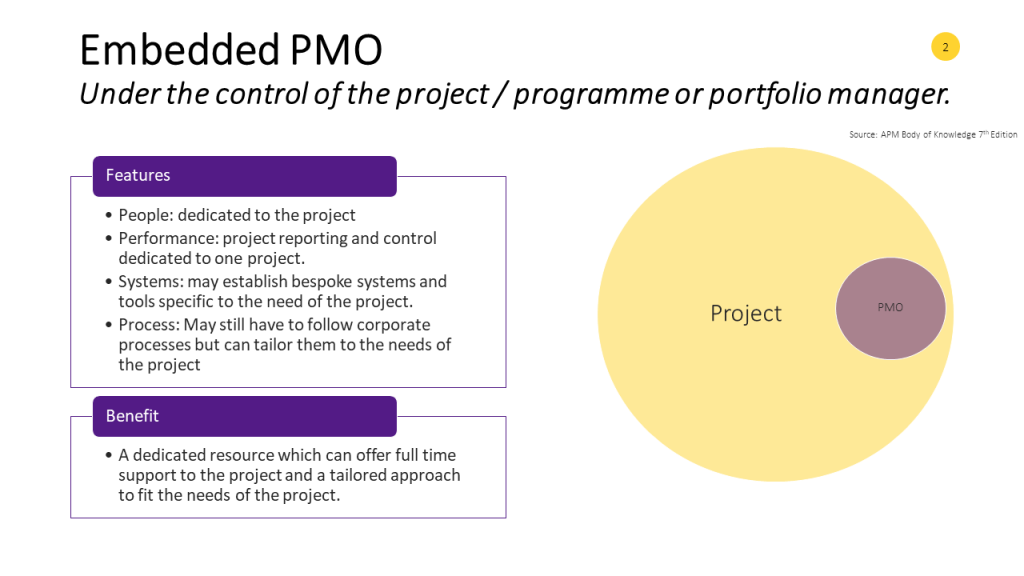
The APM say:
Embeded PMO: Under the control of the project / programme or portfolio manager..
Association for Project Management 7th Edition of the Body of Knowledge
An embedded PMO is dedicated to one project or programme, reporting to the project or programme manager. They only work on that one project and are not shared outside the project or programme. They typically last for the duration of the project and then move on to a new project once the project is finished. The reason for an embedded PMO is to support a larger and very busy project. Typical they have the following attributes.
- People: the people in the PMO are dedicated to the project. This means they can stand in for the project and have ownership and intimate knowledge of the project.
- Performance: project reporting and control dedicated to one project. So the PMO will co-ordinate or produce the progress report for the different work packages in a project.
- Systems: The PMO may establish bespoke systems and tools specific to the need of the project. Such as a project specific document control system or a work package management system. These systems can be full blown IT systems or they can be a simple as Excel spreadsheets.
- Process: The Project Management Office may still have to follow corporate processes but can tailor them to the needs of the project. For example, there may be a corporate reporting system or capital funding approval process that has to be used by the project.
These embedded PMOs tend to be expensive so they are really only used on larger projects.
Central PMO
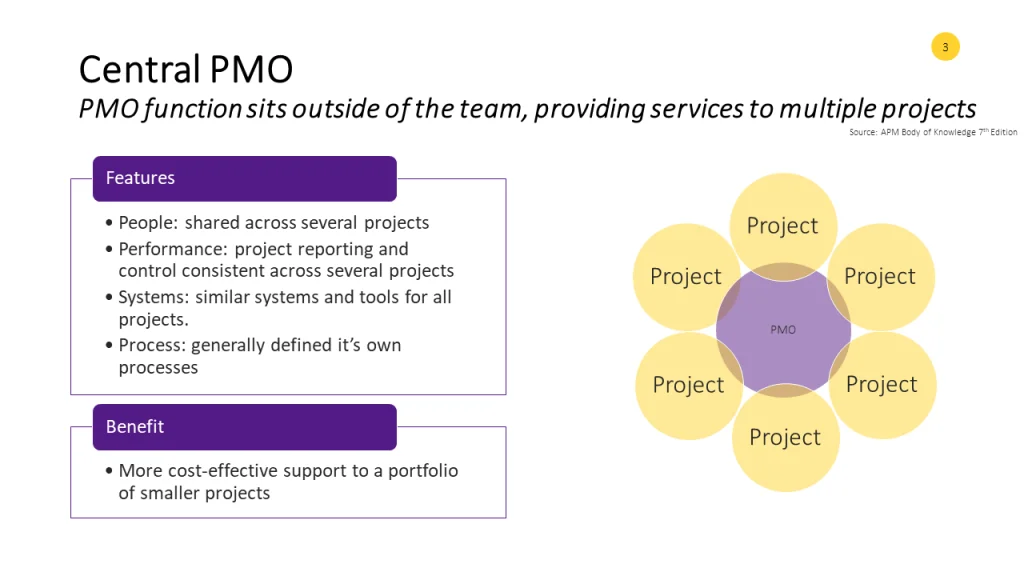
The APM say:
Central PMO: PMO function sits outside of the team, providing services to multiple projects.
Association for Project Management 7th Edition of the Body of Knowledge
A central PMO is shared across several projects. The specialist resources within the Project Management Office will support several projects at the same time. They tend to be based in a particular department, function or region. As people have to work on several projects at one time, resource management is critical. And, inevitably, they are less involved in each project when compared to an embedded PMO. However, they tend to have a longer life because they work on a portfolio of projects and learn from experience across multiple projects. Typical, they have the following attributes.
- People: the people in the PMO team are shared across several projects. They are less close to each project but can share lessons learned across different projects.
- Performance: project reporting and control tends to be systematic across all the projects supported by the PMO. This can be a beneficial service for senior managers.
- Systems: The PMO will introduce systems and tools across the collection of projects it organises. However, these are likely to be relatively simple or based on off-the-shelf systems.
- Process: A central PMO will typically define its processes and procedures and apply them across all projects.
Cental PMOs are most effective at supporting a range of smaller projects, where overall integration is not required. Typically, this might be as part of an IT department.
Hub and Spoke PMO
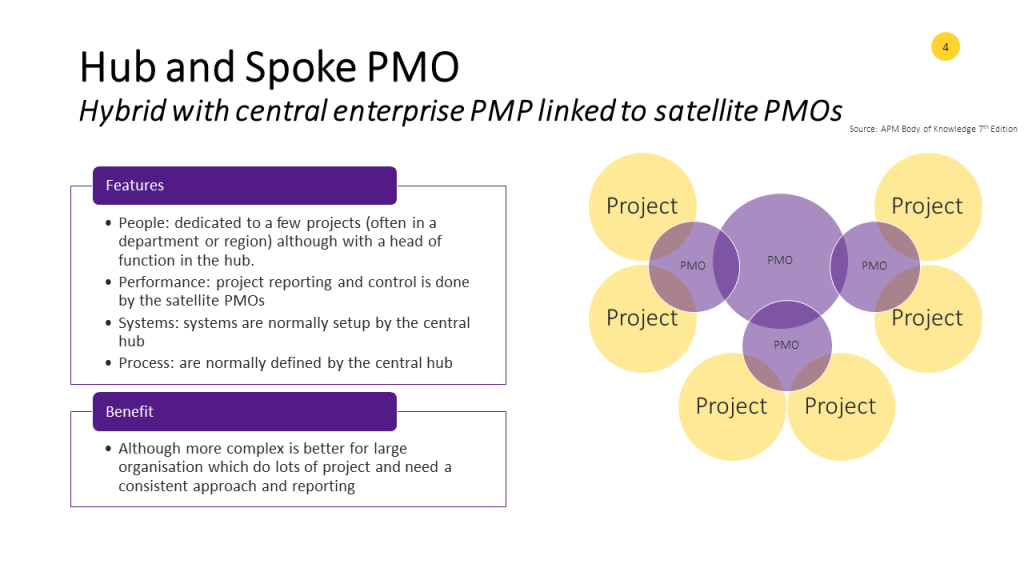
The APM say:
Hub and Spoke PMO: Hybrid with central enterprise PMP linked to satellite PMOs
Association for Project Management 7th Edition of the Body of Knowledge
In a large organisation with many thousands of projects it can be difficult for one central Project Management Office to support all the projects. Especially if the organisation is split over several regions. In this case, a Hub-and-Spoke approach can be used. The Hub works with satellite PMOs who support the projects day-to-day. Typically the Hub will define the policy, procedures and systems, while the local satellite PMOs support the projects. This type of structure can work well, but clarity is needed on what is done in the Hub and the satellite or spoke PMOs.
- People: in the satellites, work closely with the projects. The hub often includes a Head of Function, for example, there may be a Head of Document Control or Head of Risk Management. These tend to be an expert on this topic.
- Performance: project reporting and control is a collaborative effort between the hubs and satellites. Often the hub will set the policy, process and tools for reporting whilst the satellites implement the policy. You can see how this might create tensions.
- Systems: The hub has the time, effort and resources to invest in business systems to support project management. These can be full blown IT systems developed (or tailored) to the needs of the organisation.
- Process: The hub will spend a significant time developing and improving project management policy and procedures, in collaboration with the satellite PMOs
Hub-and-Spoke PMOs are most effective at supporting multiple projects across an international organisation where a consistent approach to reporting is required.
Comparison of Features Between an Embedded, Central and Hub-and-Spoke PMO
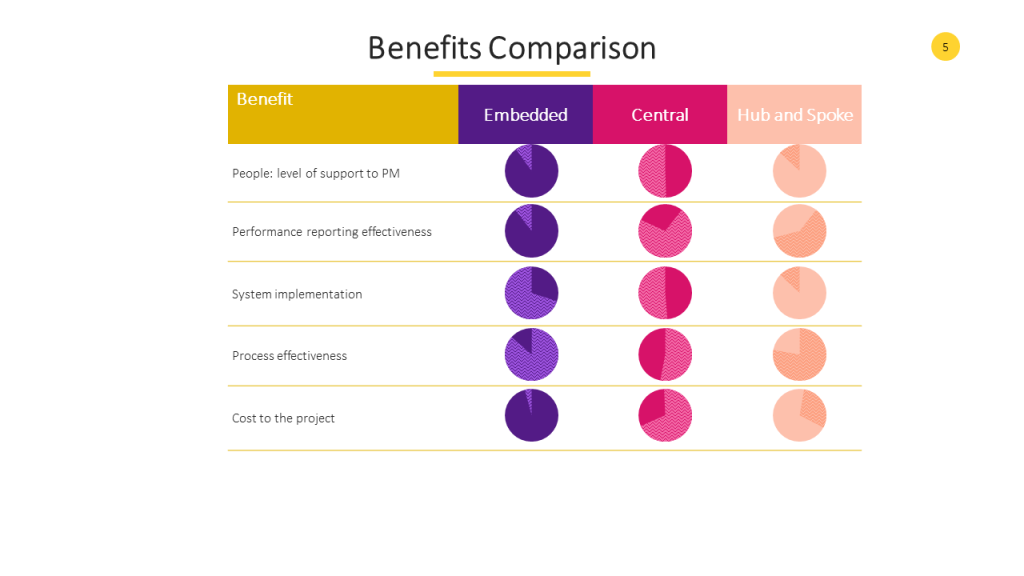
Comparing the three different PMO types. we can see they all have different strengths and weaknesses.
- People: The embedded PMO give the highest level of support to the project manager and team. Arguably a hub-and-spoke team could do similar.
- Reporting effectiveness: again, the embedded team is most likely to provide bespoke reports to meet the needs of the PM. A hub-and-spoke PMO has the challenges of coordinating approaches across large organisations.
- Systems implementation: This is where the power of the hub-and-spoke approach wins out. By having an organisation-wide approach, they can develop systems specific to the needs of the project teams in the organisation. In theory, at least.
- Process effectiveness: Again, it’s hard to beat the close integration of the embedded PMO for knowing what is going on in the project.
- Cost to the project: Here, the embedded PMO turns out to be too expensive for all but the largest projects.
Overall Comparison of Embedded, Central and Hub-and-Spoke PMO
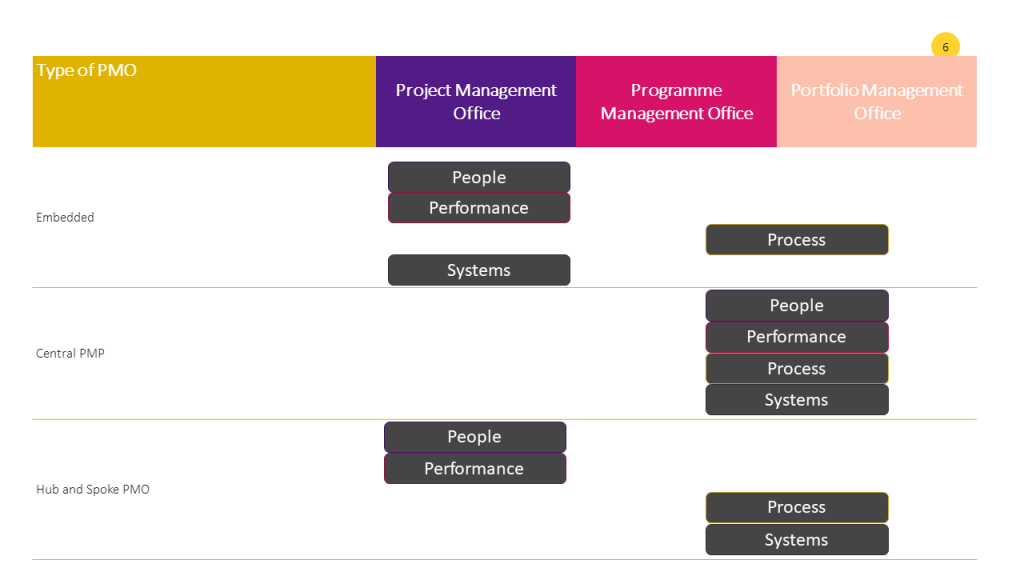
This figure from the APM Body of Knowledge sums it up. An embedded PMO takes the lead on people, performance and system. It might have to work within the overall corporate processes.
The central PMO is responsible for everything: people, performance, process and systems.
A Hub-and-Spoke PMO shares responsibility with most of the people and performance reporting close to the projects with the hub taking on responsibility for processes and systems.
Interesting….I have arrived at a similar conclusion.
I am the Executive PMO lead at NEOM. We have many moving parts within moving parts and I have developed a hybrid model not too dissimilar to the ‘hub&spoke’, one that draws on all of the benefits and minimises the dis-benefits.
In addition to delivery (through the Projects Department circa 70% of design development/delivery) there also delivery by Regions and Sectors who act as ‘client/developer’ in their own right with founding boards, they have their own budget and contract with consultants and contractors for the design and delivery.
Running concurrently with this maturing and growing organisation is the transition from Sectors to JV Partners and Subsidiaries and the transition to becoming an Authority where there will be circa 30 departments, each requiring a ‘PMO’.
A real challenge.
Carl Gomersall
ChPP
Sound like an exciting and challenging situation. For me, the most essential part of a hub and spoke model is recognises the diversity of projects in the organisation.
Hello, I’m interested in the hub and spoke model and I want to clarify, how it is with subordination in this model? Are the local PMo’s subordinate to the central one? or not necessary? Thanks in advance. With best wishes Viktorija
Different organisations implement their Hub and Spoke model in different ways. Sometimes the Hud acts in an advisory capacity with little authority. In this case that act as advocates of best practices. In other organisations, the Hub has the authority to mandate policy and procedures. This negotiation is one of the main challenges with a Hub and Spoke model.
Hello there, author! Just finished reading your article on the Parallel Project Training blog, and I must say, it was a remarkable piece. Your comparison of the different types of Project Management Office (PMO) was incredibly insightful, and I wanted to take a moment to express my appreciation.
First and foremost, I want to applaud you for the thoroughness and clarity with which you presented the various types of PMOs. Your article provided a comprehensive comparison, shedding light on the characteristics, strengths, and potential applications of each type. The side-by-side analysis and the succinct summaries made it easy to understand the distinctions and advantages of each PMO type.
Furthermore, I found your practical examples and real-world scenarios particularly valuable. By illustrating how different PMO types can be applied in various organizational contexts, you made the topic even more relatable and applicable. Your insights into the factors influencing the choice of PMO type, such as project complexity and organizational maturity, provided valuable guidance to readers navigating the selection process.
Thank you for sharing your knowledge and expertise through this article. Your passion for project management and your commitment to providing valuable resources are evident in your writing. I found your article to be a valuable reference and an excellent tool for decision-making. I’ll be sure to recommend it to others in the project management community. Keep up the outstanding work!
Hello, I would like to understand if in the embedded PMO case the PMO can operate project assurance and support with audits. Couldn’t this create a conflict of interest since the PMO is effectively within the project team?
many thanks in advance.